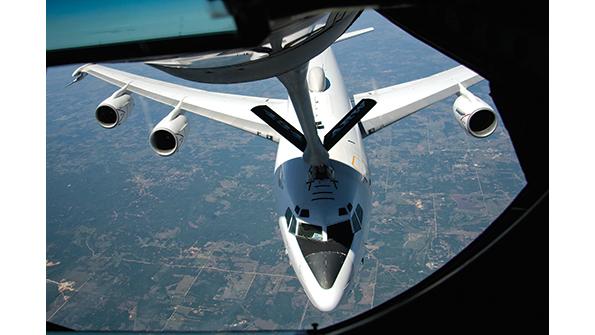
A new command-and-control system for launching land-based nuclear missiles from a flying aircraft has now entered development a year after the U.S. Air Force threw out the original plan.
The next step is for the Defense Department to select two new fleets of aircraft for the Air Force and Navy—or, possibly, a consolidated fleet—over the next five years to host the nuclear command-and-control mission systems necessary for a doomsday-attack scenario.
- Collins leading SLP-A development
- E-4B, E-6B replacements nearing decisions
Raytheon Technologies subsidiary Collins Aerospace clarified the future of the replacement for the Airborne Launch Control System (ALCS) in a Nov. 9 announcement.
The company is now the lead developer of the Secondary Launch Platform-Airborne (SLP-A) as a subeffort within the Northrop Grumman Ground-Based Strategic Deterrent (GBSD) program, which is developing the replacement for the Boeing Minuteman III intercontinental ballistic missile (ICBM).
“The SLP-A is a comprehensive nuclear command-and-control solution that we’re developing to meet the needs of the modern battlespace,” says Heather Robertson, Collins’ vice president and general manager.
Specifically, the SLP-A will replace the ALCS now installed on the U.S. Navy’s E-6B Mercury fleet. The fleet of Boeing 707 derivatives acquired 30 years ago is equipped to launch Trident II ICBMs from submarines and Minuteman IIIs from silos.
But that was not in the original plan for the nuclear modernization strategy. In 2018, the Air Force selected Lockheed Martin and Collins to develop an ALCS replacement only for the Minuteman III, despite plans to replace the ICBM with the GBSD weapon by the end of this decade.
A year later, the Air Force reversed course and terminated the ALCS replacement program. Instead, the SLP-A design will fulfill two purposes: replacing the ALCS on the E-6B to launch the Minuteman III and integrating onto a new aircraft to launch the GBSD in the future.
Such a dual-mission SLP-A program should save taxpayers about $850 million, according to a report on the Senate Armed Services Committee’s fiscal 2020 defense policy bill.
Most details of the specific technologies involved in launching nuclear weapons remain secret, but past Air Force budget documents provide basic information about the current ALCS onboard the Navy’s 16 E-6Bs based at Tinker AFB, Oklahoma.
Each ALCS onboard the E-6B consists of a suite of launch and cryptographic equipment that generates and transmits commands to the Minuteman III launch systems. The ICBM launch facilities are also equipped with a nuclear-hardened radio and an interface with the ALCS.
The E-6B fleet now serves as the airborne communications link to ICBMs deployed in land-based silos and submarines. The Air Force Global Strike Command also operates a fleet of four E-4B National Airborne Operations Centers (NAOC), which are derived from the Boeing 747-200. The E-4Bs accommodate a staff of up to 112 in the event that a nuclear attack destroyed ground-based command-and-control facilities.
As part of a slowly unfolding 20-year modernization of the entire nuclear enterprise, U.S. defense officials in 2014 began evaluating how to replace the E-6B and E-4B fleets. By 2016, an assessment completed by the Joint Staff recommended the acquisition of a consolidated fleet, along with a replacement for the Boeing 757-200-derived C-32A executive airlift fleet.
In 2019, the Pentagon’s Cost Assessment and Program Evaluation office launched an analysis of alternatives study to assess replacement options for the NAOC, Executive Airlift and Tacamo (meaning “take charge and move out”) fleets.
The so-called NEAT study was still ongoing when the Air Force launched studies for the Survivable Airborne Operations Center, which will replace the E-4B fleet. A commercial derivative aircraft could be selected in fiscal 2021, with a series of pre-engineering and manufacturing development contracts awarded to companies to define specifics such as a cabin layout, auxiliary power unit, advanced communication systems and electronic hardening for an electromagnetic pulse.
The Navy’s E-6B fleet emerged from an 18,000-hr. service life extension program about six years ago, so a replacement is scheduled for later than the E-4B’s replacement. The Navy’s budget documents call for a contract award for the E-6B replacement in the middle of fiscal 2025.
The defense secretary will decide whether to use a common aircraft to replace both fleets, says a spokeswoman for the Air Force Nuclear Weapons Center.
The aircraft that will host the SLP-A for the GBSD arsenal “has not been determined at this time,” the spokeswoman says. “The SLP-A will be adaptable and modular to accommodate future airborne platform(s).”
Editor's note: The story has been updated to correct the fact that the E-6B is equipped to launch Trident II ICBMs from submarines.






Comments
That makes 2 of us.... The editorial content seems to be going way down.